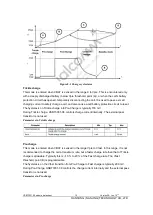
HSBT3031-08 module_datasheet
Version2.0– Jun. 15
th
HANSONG ( NANJING) TECHNOLOGY CO.,LTD
15
SYS_CTRL has no internal pull resistor, and requires an external pull-down if left undriven.
SYS_CTRL can be logically disconnected from the power on signal for internal regulators by
software. Therefore, for example, once booted, software takes control of the internal regulators
and the state of SYS_CTRL is ignored by the regulators.
7.6 LED Drivers
7.6.1 LED pads
HSBT3031-08 contains LED pads that are configurable in four different operating modes:
1. LED Driver: This mode is designed for driving LEDs. The pad operates as an open-drain
pad, tolerable of voltages up to 7.0 V. Therefore the cathode of the LED should be connected
to the HSBT3031-08 LED pad.
Each pad is rated to sink up to 50 mA of current.
2. Digital / Button input: This mode is designed for slow input signals, typically buttons. It is
not designed for fast switching digital inputs like SPI. For these types of inputs, use the
standard PIOs.
In this mode, an internal weak pull-down can be enabled. Typically this is used for active high
button signals to
ensure that the input returns to 0 when the button is released. The pads are 7.0 V tolerant and
the logic 1 threshold is typically 1 V.
In digital input mode, the logic inputs can be read by the software as virtual PIO[71, 68:66].
3. Analog input: In this mode, the LED pad is used as an analog input port. The pad voltage
is routable to a 10
‑
bit auxiliary ADC.
4. Disabled: This is the default state for LED pads, where the pad is 7.0 V tolerant and a high
impedance with no pull-down.
NOTE
LED[1] pin will be driven to ground level for up to 6 ms within 50 ms of the chip
powering up from off state or after chip reset being released.
Other LED pins might be driven to ground level for up to 300us within 50 ms of the
chip powering up from off state.
7.6.2 LED controllers
HSBT3031-08 has six PWM-based LED controllers controlled by the Applications subsystem.
Use them for driving either the LED pads (through virtual PIOs) or other available PIOs.
An application may configure the LED flash rate and ramp time using a dedicated API.
Once configured, the LED flash and ramp rate are fully hardware controlled within the
LED/PWM module. It is possible to synchronize any number of the LED drivers together. Use
the flash/ramp rate configuration to generate color change sequences on RGB LEDs.
LED outputs are able to operate in Deep Sleep state, but not in Dormant state.
















































